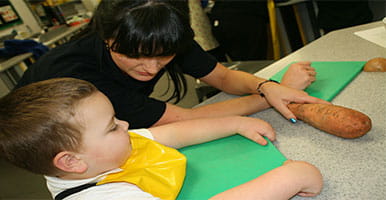Infant feeding and its impact on child health

The First 1000 days – 9 months of pregnancy and up to 2 years of an infant’s life - offer an important opportunity to enable healthy eating which will impact positively later on in life. This section details how infant feeding practices contribute to this health trajectory.
During the antenatal period pregnant women and their partners should receive evidence-based information regarding infant feeding options in order to enable them to make an informed decision on how they will feed their baby from birth.
Breastfeeding
Breastmilk is a dynamic, living fluid, providing a baby with everything it needs nutritionally until 6 months of age. The World Health Organisation recommends:
- Up to 6 months - exclusive breastfeeding
- 6 months to 2 years (and beyond) - continuing to breastfeed whilst providing nutritious complementary foods
Benefits of breastfeeding
Breastfeeding delivers numerous health benefits for mother and baby.
For the baby, these include short term benefits such as lower risk of infections, fewer instances of diarrhoea and vomiting, and reduced risk of sudden infant death syndrome. But there are also longer-term health benefits such as reduced risk of childhood obesity and reduced risk of cardiovascular disease in adulthood.
For the mother, it can lower the risk of breast and ovarian cancer, osteoporosis, and cardiovascular disease. This is thought to be due to breastfeeding’s effect on hormones. It can also help to build an emotional bond between mother and baby.
Why is breastmilk so good for babies?
Breastmilk contains a number of live constituents which promote infant health. These include:
- Water - up to 80% of breastmilk is water, babies who are exclusively breastfed do not require water in addition to breastmilk
- Protein - including forms of protein that are easy to digest and associated with cancer cell destruction
- Carbohydrates - Lactose is the main carbohydrate, providing around 40% of the total calories
- Fats - essential for absorption of fat-soluble vitamins, and a major calorie source. Important for development of the brain, nervous system and eyesight, and some potential links to IQ
- Vitamins and minerals - essential for the health of the baby’s body, from healing wounds and supporting bone growth to bolstering the immune system. Iron prevents anaemia and calcium is important for healthy bones and teeth
- Other factors - Breast milk also contains a number of other biologically active factors and cells important for growth, internal repair, destroying harmful bacteria and protecting the gut.
Encouraging mothers to breastfeed
The National Institute for Health and Care Excellence states that at 36 weeks all pregnant women and their partners should be given information about breastfeeding to enable a positive start.
The UNICEF UK Baby Friendly Initiative (BFI) provides a user-friendly leaflet regarding technique and management of breastfeeding which can be useful to talk through with pregnant women. All Information should be non-judgmental, culturally sensitive and family-centred, in order to meet mothers’ and their family’s needs.
As outlined in the communicating about weight module, you can’t motivate someone else to do something. But you can create an environment in which women are more likely to want to breastfeed.
By providing education and support, without pressure, you can help women feel more confident about breastfeeding and begin to see the value in having a go.
It can be helpful to think of this in terms of enhancing women’s feelings of autonomy, competence and relatedness (see communication module for examples of how this can be achieved in a consultation):
- Autonomy – Help women understand the benefits of breastfeeding for themselves and their baby, which will help them make an informed choice. You might share the World Health Organisation recommendations (and explain why this is recommended), but try not to put pressure on women to breastfeed since this can create/strengthen resistance. Instead give women information to take away (e.g., UNICEF BFI leaflet), encourage them to talk it through with their partner and/or family and make the decision in their own time.
- Competence – Help women understand that breastfeeding can be beneficial even if done only for a short time. By helping women focus on one small step at a time they may feel less overwhelmed and feel able to “try it out” and see how it goes.
- Relatedness – Show you’re there to support the mother and give her opportunities to ask questions or talk about anything that concerns her. If there is an opportunity to do so, involve the partner and/or family in conversations related to breastfeeding, as this can help mothers establish and continue to breastfeed.
Positioning and attachment
Good position and attachment are the mainstays of successful breastfeeding. Mothers should be supported to achieve these by practitioners who have undertaken breastfeeding training. The following BFI breastfeeding assessment tools can be used by practitioners and mothers themselves to assess whether their baby is breastfeeding well and safely:
Responsive breastfeeding
Breastfeeding should be ‘responsive’, which means a mother responds to her baby’s cues and offers the breast for nutrition, comfort or her own needs.
It is important for mothers to understand some key principles:
- responsive breastfeeding does not lead to overfeeding
- restricted/scheduled breastfeeding can lead to a baby not being satiated, can disrupt milk supply and lead to early discontinuation of breastfeeding
- combining breastfeeding with formula feeding (combi-feeding) can also have a detrimental effect on breastmilk supply
For further information, the UNICEF BFI provides an infosheet with further guidance for supporting mothers with responsive breastfeeding.
Expressing breastmilk
All breastfeeding mothers should be taught how to hand express breastmilk and to store it safely, to enable their baby to continue to receive breastmilk when they are not available.
The breastfeeding network has an excellent resource sheet on hand expression and storage of breastmilk that can be helpful to share with mothers.
Many mothers describe not being able to express breastmilk effectively. This hand expression checklist from the BFI contains some helpful tips for supporting mothers to express effectively, and highlights signs and symptoms that might require specialist support (e.g. infant feeding teams, lactation consultants, breastfeeding peer support personnel).
Extra fluids
Breastfed babies do not require extra fluids (even in hot weather) as breastmilk accommodates any increase in thirst.
Formula feeding
Not all mothers choose to breastfeed. In addition, some mothers will begin breastfeeding but due to various factors will move over to formula feeding. In the UK, the majority of mothers bottle feed their baby with formula milk by 6 weeks of age.
Although the health benefits of breastfeeding do outweigh those of formula feeding, formula milk is nutritionally sufficient for young babies. Formula-fed babies are however more likely than breastfed babies to receive excess calories and show rapid weight gain.
It is important for mothers/caregivers to bottle feed their baby responsively, as this enables a baby to self-regulate its milk intake, can reduce over feeding and promote healthy weight gain.
Responsive bottle feeding
Responsive bottle feeding is when a mother responds to her baby’s feeding cues, allowing the baby to initiate and regulate its formula milk intake. When practised it can be used to prevent overfeeding and subsequent obesity.
Tips for responsive bottle feeding
- Babies should be semi-upright with their mother maintaining eye contact. This enables them to be responsive to their baby’s feeding cues (baby becomes restless, rooting, chewing fist/fingers).
- Babies should be allowed to find the teat by gently brushing it against the baby’s lips.
- The bottle should be held horizontally so that the teat is just full, ensuring milk ingestion is not too rapid.
- Pacing a bottle feed and taking regular breaks during the feed allows babies to recognise when they are full and reduces over feeding.
- Formula feeding should be limited to a small number of caregivers so that bonding and responsive feeding can be undertaken effectively.
- Young babies feed little and often and should not be forced to finish a bottle. This has not been found to make a baby go longer between feeds and can lead to overfeeding.
- Babies should not be offered a bottle to comfort them as this can lead to overfeeding and mothers should be encouraged to find other ways to soothe and comfort their baby.
Bottle feeding safely
It is important bottles of formula are made up safely to reduce the risk of illness and admission to hospital (See NHS guidance for how to make up baby formula safely).
Caregivers should always follow the manufacturer’s guidelines for making up the formula. Too much formula powder can lead to dehydration or constipation. Too little formula powder can reduce a baby’s nutritional intake. Nothing extra should be added to the bottle (e.g., cereal, sugar, juice) as this introduces ‘free sugars’ that can lead to unnecessary weight gain and tooth decay.
Babies should not be left to ‘prop feed’ (where a baby’s bottle is propped up against a cushion or some other support, rather than the caregiver holding it) as this can lead to choking. They should also not be allowed to go to bed with a bottle.
If extra fluids are required
If the weather is hot a formula fed baby under 6 months can be given cool boiled water, after 6 months they can have tap water. No babies should be given bottled water due to increased sodium content and immature kidney function.



